Adding value for ALL RS sailors
- Sets the rules to give great one-design and handicap racing - enhancing resale values
- Organises websites, race reports, news, social media - keeping you informed
- Organises racing events with fantastic social scene - improving your Class’s popularity and value
- Organises training events - helping you get the most from your boat
- Liaises with the builder, RS Sailing - ensuring the quality and specification are what owners want
- Negotiates excellent discounts from the RS Sailing Store, including sail discounts, and many other companies
- Encourages new people to get involved - giving a better experience for everyone
Who is your Class Association?
- It is run by volunteer sailors with back-up by part time professional administrators
- The sailors make the plans and decisions - without having to do all the leg work
Please show support by joining your Class Association
- The cost is tiny compared to your benefits, working out at just £3.75 per month for Full Membership, £3 per month for Club Membership or £2.08 per month for Youth Membership
- By taking out International Class Association membership for one class, you will have reciprocal membership to the RS100, RS200, RS300, RS400, RS600, RS700, RS800, RS Vareo International and International RS500 Class Associations
- One event membership is available for all events except National and major championships, for use by those borrowing a boat, intending to only sail in one RS Class Association event etc. Click here.
Join Online
The Boat - technical
Pete Vincent, from west Country Boat Repairs talks us through
Posted: 16/03/2009 11:04:54Changing the Slot Gasket
For RS200 and RS400 owners one of the worst things that can happen is your slot gasket come off in the middle of a race and turn your boat into a plastic fountain. So regularly checking your slot gasket and changing it when it shows signs of age with small tears or staying open when the board is fully retracted will save a lot of grief.
Changing a slot gasket does involve a fair bit of time but could be made a lot easier by following some simple guidelines. First get the boat dry and get it into a position where it is going to remain dry. Allow yourself enough time to change the gasket before next sailing. It will probably take you about 90 minutes to remove old gasket and fit a new one. You should leave the new gasket to cure for 8-12 hours.
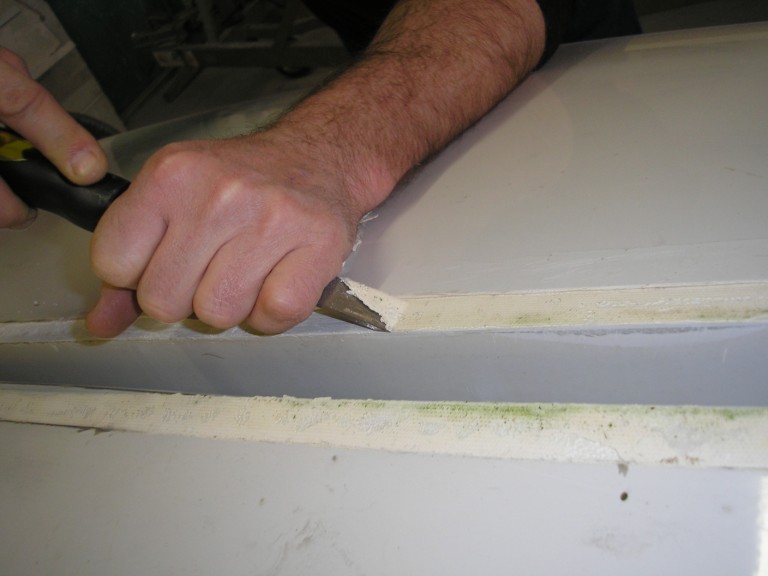
When the boats are built the slot gasket is put on using sikoflex.
When you peel off the old gasket much of the sikoflex will be left behind attached to the hull. The real secret to successfully fitting a new gasket is completely removing all this old material. Do not attempt to stick a new gasket on top of this old sikoflex; it will not stay attached very long. Buy yourself a new sharp chisel, the £2 invested will save a huge amount of time, and use this to remove the sikoflex.
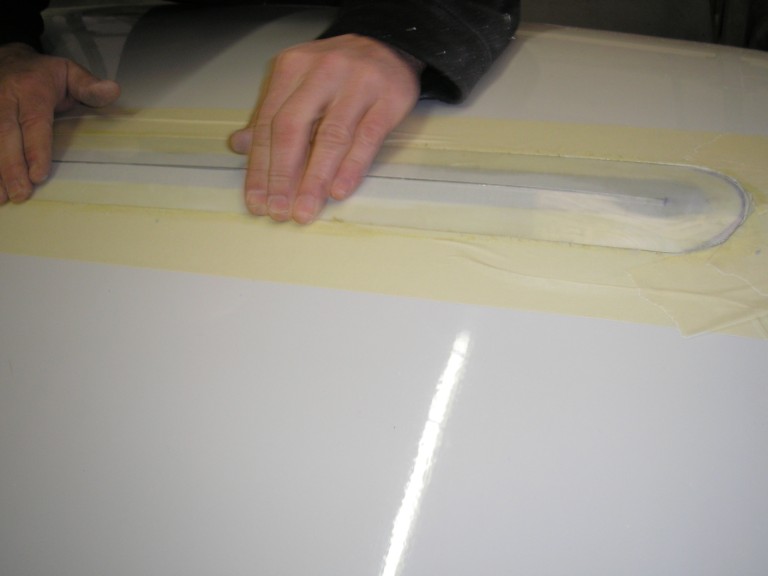
It is not important if you do make some small gouges in the recess in the hull for the gasket. Then wrap a piece of coarse sandpaper around a block and carefully rub down the recess to remove small flakes left.
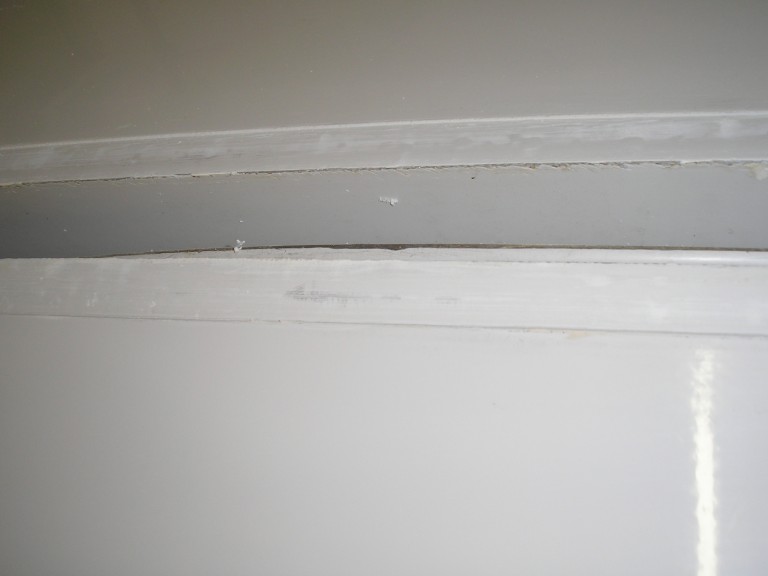
Attach wide masking tape to the hull directly beside the edge of the recess; this will stop excess glue sticking to the hull and save a lot of cleaning time. Then brush down the recess and get rid of dust. The boat must be totally dry before trying to attach a new gasket.
Then prepare the new gasket. Put the length on the boat and trace the shape of the recess at the front, trim to right shape. Then cut gasket at rear so the gasket is flush against bailer housing. There is no need to try and fit the gasket under the bailer; this is virtually impossible to prise off without breaking the bailer.
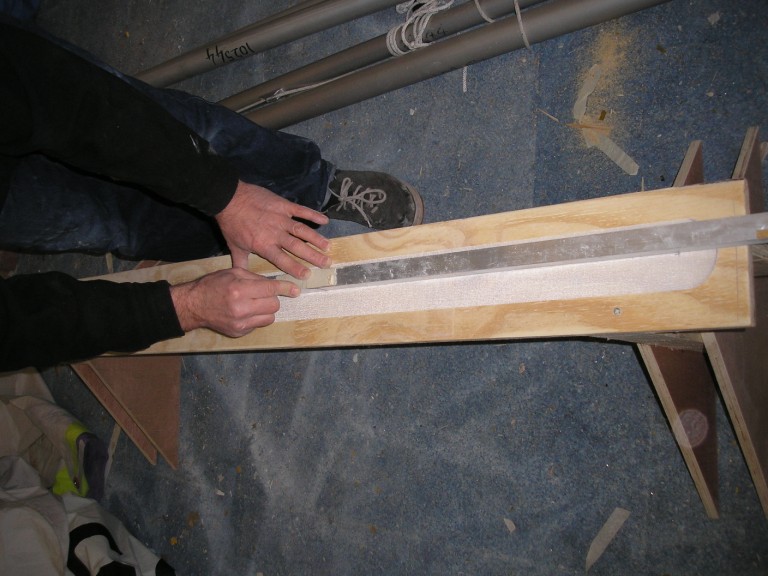
Then lay the new gasket on a flat surface and carefully trace a centreline, this does not have go right to the front of the gasket. Use a sharp knife to cut the centreline using a straight edge as a guide. It is so much easier to pre cut the opening in this way than when the gasket is fitted to boat. We put masking tape on to close the new opening to make it easier to handle gasket when fixing the gasket to boat. Then rub down the underside of the gasket with coarse sandpaper; this fluffs up the underside increasing surface area to give a better bond.
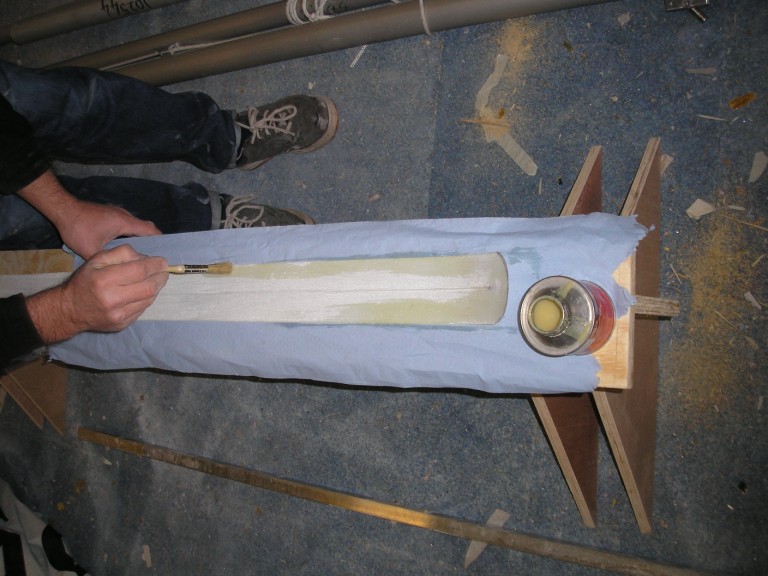
We use a good contact adhesive to fix new gasket; it’s a lot less messy than sikoflex, gives just a good bond and does not leave so much material when replacing the gasket in the future. Coat both the underside of the gasket and recess with adhesive. Then carefully put new gasket into recess, attaching from the front back pushing down a small area at a time taking care to ensure the gasket is lining up correctly. Once in position run over whole gasket to ensure its firmly attached in all areas. Tape the gasket down firmly so it is held in place whilst the adhesive is curing.
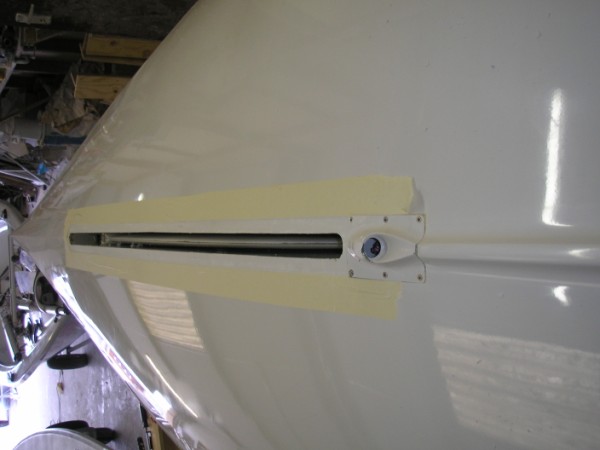
Gunwhale hung trolley
Posted: 02/02/2006
Following request we have developed a new gunwhale hung launching trolley
for the RS200. The trolley will support the boat under the gunwhales at
the bow as well as the middle of the boat. It will be available as an
option from mid February onwards..Mast step
Posted: 21/10/2005
In approx Jan 2004 Selden changed from making their mast steps in
aluminium alloy to a composite material. This had been tested on 470s and
Fireballs for over a year. This material proved to not be strong enough
for the RS200. After the first failure known to LDC, Selden were asked to
change back to aluminium alloy for 200 mast steps. If anyone still has a
composite step, contact LDC who will issue a free of charge replacement. Spreader system
Posted: 21/10/2005
Selden updated their spreader system, across their whole dinghy mast
range, early in 2004. The old barrel system was very susceptible to
corrosion and jambing unless frequently used / maintained.
The new pin and hole system has slightly coarser adjustment, but its
simplicity gives strength and trouble free use.
Inevitably, some people prefer the old system, but the improvements
counterbalance the drawback. In addition, it has always been our aim to
use standard manufactured parts where possible to speed up the supply
chain and so that spares can be more readily obtained by sailors all over
the world should they need to.Creased jibs
Posted: 21/10/2005
A number of jibs were creased by being crushed during delivery this year. They are now being being supplied wrapped around card tubes and will eventually be supplied inside larger tubes.
On the topic of availability of sails - the supply problem of sail logos earlier this season should be a thing of the past as we aim to hold them in stock now.Rudder stock lower gudgeon
Posted: 21/10/2005
The lower gudgeons were fitted for a while using bolts that fitted flush
inside and out on the stock. They looked much better, but proved prone to
working loose. The gudgeons are now fitted using bolts that have the nut
on the outside of the stock - ugly but effective and easy to tighten up.
The flush fit bolts can be replaced, but are not always easy to remove. Mast heel plug
Posted: 21/10/2005
In 2003 Selden updated the heel plug for their Cumulus mast section, as
used on the RS200 and RS400. The original alloy fitting had been less
than perfect in that it could be fitted out of alignment in error. The
new heel plug is made from a composite material and can only be fitted
with the tenon aligned with the mast section. Some of the new heel plugs
cracked around the flange that the mast sits on. This flange was quickly
thickened and the pin slot moved to the forward part of the tenon. No new
spec heel plugs have failed as far as we are aware.
Most of the first batch of composite tenons have been replaced. It does
appear, however, that Selden inadvertantly fitted one of the first draft
composite heel plugs to a mast produced in 2005. They are confident
that all of these plugs have now been thrown out so this error should not
happen again.
RS200 Self Bailer Moulding
Posted: 25/01/2005
The RS200/400 self bailer moulding has always been a slightly awkward fit
on the RS200 hull. Keen sailors have often done a bit of fairing work on
their bailers. There has also been a potential leak point due to the
screws.
LDC has confirmed that they have now produced a new bailer moulding,
specifically for the 200, which fits more neatly and can therefore be
glued in place - no screws. There is very little difference from the
original, other than the way it sits around the hull skeg, immediately
behind the bailer "scoop". This area is in the water flow shadow of the
scoop, so it is not imagined that one would be able to detect any
difference in drag (and therefore boatspeed) from a well faired old style
bailer.
The RS Association reps have confirmed that they are happy with this
slight change, and LDC will start fitting new bailer mouldings from the
end of January 2005. RS200 Tweaker Line Changes - Outcome of Vote
Posted: 17/06/2004
Further to the recent vote to amend the RS200 class rules to permit -
1. The installation of a sheave box in place of the plastic grommet
where the tweaker line exits the mast;
2. The removal of the tweaker line from the mast;
3. The spinnaker halyard to enter the mast through the lower (tweaker
line sheave box; and
4. To remove the inferred requirement for the RS200 to remain able to
deploy the "Square Running System" (SRS) at any time while racing.
we now have a very definite decision.
85 (27%) of RS200 members voted, with 80 (94%) of these voting for the
proposal.
The rules have been amended accordingly and are on the website. If you
would like to receive a copy of the new rules or further information
about the change, please contact the RS Office.





